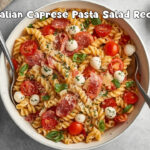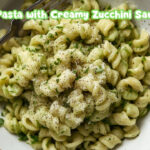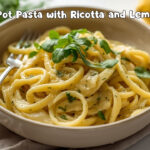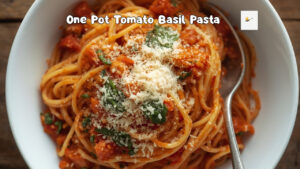Table of Contents
ToggleSometimes, you prep meals… sometimes, you melt cheese on everything.
Of course, we’re talking about Gruyère cheese, which has excellent melting properties. It has a nutty, slightly sweet flavor and creamy texture, often used for comfort food dishes. But while Gruyère cheese has an exceptional taste and can also be pricey—Swiss, Emmental, and Comté cheese are the best gruyère cheese substitutes that can be used in its absence.
If you’re looking to swap Gruyère or want to try something new, many alternatives melt beautifully and taste great. Here are 16 excellent Gruyère cheese substitutes, both dairy and dairy-free or plant-based. Please keep reading and use them in your favorite recipes.
What is Gruyère Cheese?
Gruyère is a popular semi-hard cheese from Switzerland, named after the French-speaking town of Gruyère in the canton of Fribourg, pronounced as “groo-yehr.” Gruyère cheese is made from raw cow’s milk, usually aged for 3 to 10 months or maybe longer. It is produced with very few holes and in pale-yellow cheese. It is known for its creamy texture and nutty, slightly sweet flavor. Gruyère is ideal for baking or slicing on grilled cheese sandwiches to melting in fondue or French onion soup and is often grated over Pasta and salads. It also pairs well with white wines like Riesling.

Although Gruyère originally comes from Switzerland, similar cheeses are made in other countries, such as France, the U.S., Germany, Austria, and the Netherlands.
But if you’re looking for a good Gruyère cheese substitutes , you can try many other great melting cheeses. Grab your cheese grater, and let’s explore the best options!
The Best Gruyère Cheese Substitutes
1. Gouda
Gouda is a semi-hard Dutch cheese like Gruyère. Both cheeses have a rich and delicious flavor, and while Gouda is milder and creamier than Gruyère, it is still a good substitute for gruyère cheese in many recipes. Gouda melts well in many dishes like grilled sandwiches, cheese soups, pizza, or Flatbreads.
But the big difference between the two lies in their origins. Gruyère is a Swiss cheese produced in the Gruyère region that is aged for longer to create a strong, nutty flavor. On the other hand, Gouda comes from the city of Gouda in the Netherlands, which is also made from cow’s milk but has a smoother texture and milder taste. Gruyère pairs well with bold drinks like wine and beer, while Gouda is more versatile and enjoyed with fruits, nuts, crackers, or jams.
Great for:
- Mac & Cheese
- Grilled Cheese Sandwiches
- Cheese Boards & Snacks
2. Emmental
If you want the closest match, Emmental, also called Swiss cheese, is your best bet. This smooth, semi-hard Swiss cheese is actually used alongside Gruyère in traditional fondue recipes. Both come from Switzerland and have a sweet, nutty taste with larger holes throughout. Emmetal has a milder, butterier flavor than Gruyère but melts beautifully and works well in gratins, sandwiches, and casseroles.
Great for:
- Fondue
- Quiche
- French onion soup
- Baked dishes
3. American Swiss Cheese
Swiss cheese comes from the same country as Gruyère and can be used in similar ways, but it is made in the style of Emmental. It is made from cow’s milk and has a slightly sweet, nutty taste. It is milder and more buttery. Swiss cheese melts really nicely, so it’s a great choice for things like Fondue or Quiche.
One main difference between Gruyère and Swiss cheese is how long they’re aged. Gruyère is aged longer, which gives it a stronger taste and a firmer texture, but Swiss cheese is aged for a shorter time, so it’s softer and stretchier. The classic American Swiss cheese brings taste to your cooking.
Great for:
- Melty sandwiches
- Casseroles
- Sandwiches or burgers
4. Comté
Comté cheese is a French cheese made from cow’s milk and similar to Gruyère. Both are aged and have rich, complex flavors and a pleasant smell. Younger Comté is great for melting. Comté tastes a little sweeter and fruity, closely resembling Gruyère. Because of these similarities, this is one of the best among Gruyère cheese substitutes and can be used in many recipes.
Great for:
- Grilled cheese Quiche
- Fondue
- Cheese plates
5. Fontina
Fontina is an Italian Alpine cheese. It is a soft, creamy cheese from Italy that you can easily swap with Gruyère in a few recipes. Fontina doesn’t have the same nutty taste, but it does have a mild, earthy flavor. It also melts really well, which makes it a great choice for dishes like quiches or pasta bakes. Look for Fontina Val d’Aosta (the traditional version) for the best results.
Great for:
- Pizza
- Mac and cheese
- Baked pasta dishes
6. L’Etivaz
L’Etivaz cheese is very similar to Gruyère. Both are traditional Swiss cheeses made from raw cow’s milk aged for at least five months. L’Etivaz cheese has a rich, nutty, slightly fruity flavor and a firm texture, making it excellent for melting fondue, gratins, and French onion soup. These similarities make it a good Gruyère cheese substitute in many recipes.
L’Etivaz is often considered a special, more old-fashioned version of Gruyère, which is made using traditional methods. One key difference between them is that L’Etivaz is produced only in the summer months when cows graze on fresh Alpine grass, making it more special. L’Etivaz is handmade seasonal cheese that is hard to find in stores.
Great for:
- French onion soup
- Gratin dishes
- Salads or roasted vegetables
7. Beaufort
Beaufort is a French Alpine cheese similar to Gruyère. Both cheeses are made from cow’s milk. Beaufort has a silky and delicate texture but a slightly milder buttery flavor. It is not as strong as Gruyère’s, but it still works really well, and you can use it in dishes like fondue or soup.
Great for:
- Fondue
- Soups
- Sauces
- Tartiflette
8. Jarlsberg
This mild Norwegian cheese is a cousin of Emmental, which comes from Norway. It has large holes and a milder flavor. Jarlsberg is slightly flexible in texture and melts well, which makes it a good alternative for Gruyère. It is easily available in grocery stores and works great in dishes like quiches, grilled cheese sandwiches, or any recipe that needs a smooth, melty cheese.
Great for:
- Ham and cheese sandwiches
- Fondues
- Baked potatoes
9. Maasdam
Maasdam cheese is a semi-hard cheese produced in the Netherlands and made from pasteurized cow’s milk. It is also known as Dutch Swiss cheese. It has a sweet, fruity, and nutty flavor with large holes, like Swiss cheese. However, it is milder and doesn’t taste exactly like Gruyère. Still, its melting properties are similar enough, making it a good among other gruyère cheese substitutes in dishes like gratins, hot sandwiches, or casseroles.
Great for:
- Casseroles and Bakes
- Macaroni and Cheese
- Cheese Boards
10.Raclette
Raclette is a bold traditional Swiss cheese—literally, it is built for melting. While it shares Gruyère’s nutty flavor, Raclette has a stronger smell that not everyone may like. Still, it gives a gooey, smooth texture when melted in recipes like cheesy casseroles, gratins, or creamy cheese sauces. It’s a great alternative to Gruyère and popular for dishes where melted cheese is the star.
Great for:
- Raclette dinners
- Fondue
- Potato dishes
11.Cheddar
Cheddar isn’t just a flavor twin of Gruyère but also a go-to melter that is easy to find. Cheddar is one of the best among Gruyère cheese substitutes for a closer match, so it is always my number one choice. Its bold flavor gives a fun new twist to dishes. It melts similarly in cooked dishes, like Fontina or Comté.
Great for:
- Mac and cheese
- Grilled sandwiches
- Cheese sauces
12.Edam
Edam cheese is a mellow Dutch cheese with a complex but smooth consistency. It is known for its mild and slightly salty flavor. It doesn’t give you the same depth of flavor as Gruyère, but its creamy and smooth texture makes it a flexible choice for many recipes that call for mild, melty cheese, like baked and cheesy dishes.
Great for:
- Baked Pasta
- Sandwiches
- Cheesy bread
13.Appenzeller
Appenzeller is a Swiss cheese that’s slightly stronger and more herbal than Gruyère. It has a robust, savory flavor with hints of herbs and nuts. This cheese is traditionally washed in a mixture of wine, cider, or herbs during the aging process, which adds a unique twist to recipes that typically use Gruyère, which gives it a firm texture when cooked.
Because of its bold taste, Appenzeller is a good substitute for Gruyère in recipes that need a rich flavor. It melts really well, and it’s great in dishes like gratins, toasted sandwiches, and casseroles where you want the cheese to stand out and add extra flavor.
Great for:
- Cheese platters
- Soups
- Quiches
14.Provolone Cheese
Provolone is another semi-hard Italian cheese made from cow’s milk. Aged Provolone has a sharper, more complex flavor, making it a closer match to aged Gruyère. Provolone melts really well, turns soft and gooey when heated, and offers a savory richness to dishes like fondues, casseroles, and baked steaks.
Great for:
- Cheese steaks
- Pizza
- Grilled cheese sandwiches
15.Parmesan Cheese
Parmesan is a more rigid cheese and doesn’t melt like Gruyère. It has a rich, nutty, and bitter taste that works great in baked dishes like quiches, pasta bakes, or gratins but doesn’t melt as smoothly in dishes. Parmesan cheese can be a good alternative to Gruyère in recipes where you want a substantial, delicious depth of cheesy flavor rather than smooth melting.
Great for:
- Salads
- Risotto
- Pasta bakes
16.Wensleydale
Wensleydale cheese has a creamy-crumbly texture made from cow’s milk and is produced in England. It has a mild and slightly sweet taste and gentler flavor and is often paired with fruits and nuts. This makes it a good salad option and is commonly used in desserts. Even though it doesn’t have the nutty taste of Gruyère, it is still preferably used to add gentle flavor to many dishes. It’s a great choice if you like cheeses with a softer, milder flavor instead of something strong or sharp.
Great for:
- Savory pastries
- Dessert cheese plates
- Salads
Dairy-Free Gruyère Cheese Substitutes
Here are my favorite vegan or non-dairy Gruyère Cheese Substitutes, which are similar to Gruyère in melting properties.
1. Nutritional Yeast Flakes
- Why it works: Adds a cheesy, savory (umami) taste
- Best used in Soups, sauces, sprinkled over vegetables
- Tip: Use sparingly for the best effect
2. Hummus
- Why it works: Creamy with a nutty flavor
- Best used in Onion soup, sandwiches, grain bowls
- Tip: It doesn’t melt but adds richness and body
3. Dairy-Free Pesto
- Why it works: Packed with flavor and freshness
- Best used in: Gratin dishes, roasted veggies, Pasta
- Tip: Try tomato almond pesto or Sicilian nut pesto
4. Brazil Nuts
- Why it works: It can be grated like cheese
- Best used in Pasta, casseroles, baked dishes
- Tip: Use a microplane for a “Gruyère dust” effect
5. Olives
- Why it works: Gives a salty punch like cheese
- Best used in Salads, Pasta, baked dishes
- Tip: Use chopped olives to mimic cheesy bites
6. Sun-Dried Tomatoes
- Why it works: Full of flavor with a sweet note
- Best used in: Quiches, sandwiches, pastas
- Tip: A great replacement for cheese in savory dishes
7. Toasted Breadcrumbs aka (“Poor Man’s Parmesan”)
- Why it works: Adds crunch and golden color
- Best used in Pasta, casseroles, baked dishes
- Tip: Sprinkle on top like cheese before baking
8. Salted Roasted Almonds
- Why it works: It adds crunch and saltiness
- Best used in Salads, rice bowls, roasted veggie dishes
- Tip: Chop or crush for better texture in recipes
9. Capers
- Why it works: Salty and tangy like aged cheese
- Best used in Pasta, grain salads, vegetable dishes
- Tip: Salted capers are better, but vinegar-packed ones work too
10.Sea Salt Flakes
- Why it works: It brings the salty kick that Gruyère gives
- Best used in: Almost any dish needing more flavor
- Tip: Use as a final topping after cooking
How to store Gruyère cheese?

Wrapping Gruyère cheese loosely in wax or parchment paper keeps it fresh. Store it in the fridge’s vegetable drawer for several months. I usually ignore using the best-before date and still eat it weeks later, ensuring rewrapping after each use. You can freeze it for more extended storage, but the texture may change. As it stays longer in the fridge, it’s often not necessary.
What to Serve with Gruyère Cheese?
- Bread & Crackers
- Meats
- Fruits
- Roasted vegetables
- Wines
- Nuts
Additional Ingredient Alternatives
- Blue Cheese
- Butter
- Cream
- Crème Fraîche
- Double Cream
- Feta Cheese
- Goats Cheese
- Gorgonzola
- Greek Yoghurt
Final Thoughts
If you don’t have Gruyère, you’re sticking to a budget, or experimenting in the kitchen, there are many other cheeses you can try that have a similar taste or texture. Gouda, Swiss, Fontina, and others can work well in different recipes, with excellent results in everything from soup to fondue. Trying out these Gruyère cheese substitutes and bring fun flavors to your cooking. So don’t hesitate to experiment and enjoy the wide variety of cheese.
So, grab your grater—and a glass of wine—and let the melting begin!
Frequently Asked Questions About Gruyère Cheese Substitutes
What other cheese does gruyère cheese taste like?
Gruyère has a nutty, slightly sweet flavor. Other cheeses, like Emmental, Comté, Jarlsberg, and Beaufort, are made with milk and good for melting, and they taste kind of like Gruyère cheese.
How to make Gruyère cheese?
Gruyère cheese is made by heating raw cow’s milk, acidifying it, and then adding culture and rennet. The curds are cut and cooked. They are then pressed into a mold, salted, and aged for months, creating a nutty flavor.
What is Gruyère cheese best used for?
Gruyère is known for its best melting ability. It is often mixed with Emmental in real cheese fondue, and that’s why it is a smoother, tastier option for melting, cooking, and grating over dishes than cheddar. This traditional cheese is commonly paired with ham in the famous French grilled sandwich and Quiche.













